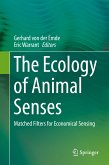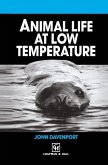Michael Warburg
Ecophysiology of Amphibians Inhabiting Xeric Environments (eBook, PDF)
112,95 €
112,95 €
inkl. MwSt.
Sofort per Download lieferbar

56 °P sammeln
112,95 €
Als Download kaufen

112,95 €
inkl. MwSt.
Sofort per Download lieferbar

56 °P sammeln
Jetzt verschenken
Alle Infos zum eBook verschenken
112,95 €
inkl. MwSt.
Sofort per Download lieferbar
Alle Infos zum eBook verschenken

56 °P sammeln
Michael Warburg
Ecophysiology of Amphibians Inhabiting Xeric Environments (eBook, PDF)
- Format: PDF
- Merkliste
- Auf die Merkliste
- Bewerten Bewerten
- Teilen
- Produkt teilen
- Produkterinnerung
- Produkterinnerung

Bitte loggen Sie sich zunächst in Ihr Kundenkonto ein oder registrieren Sie sich bei
bücher.de, um das eBook-Abo tolino select nutzen zu können.
Hier können Sie sich einloggen
Hier können Sie sich einloggen
Sie sind bereits eingeloggt. Klicken Sie auf 2. tolino select Abo, um fortzufahren.

Bitte loggen Sie sich zunächst in Ihr Kundenkonto ein oder registrieren Sie sich bei bücher.de, um das eBook-Abo tolino select nutzen zu können.
The book describes how special organ structures, behavioural patterns and physiological adaptations enable amphibians to survive in hot and dry environments.
- Geräte: PC
- ohne Kopierschutz
- eBook Hilfe
- Größe: 21.45MB
Andere Kunden interessierten sich auch für
![Homeostasis in Desert Reptiles (eBook, PDF) Homeostasis in Desert Reptiles (eBook, PDF)]() Sidney Donald BradshawHomeostasis in Desert Reptiles (eBook, PDF)72,95 €
Sidney Donald BradshawHomeostasis in Desert Reptiles (eBook, PDF)72,95 €![Spider Ecophysiology (eBook, PDF) Spider Ecophysiology (eBook, PDF)]() Spider Ecophysiology (eBook, PDF)160,95 €
Spider Ecophysiology (eBook, PDF)160,95 €![Ecophysiology of Desert Arthropods and Reptiles (eBook, PDF) Ecophysiology of Desert Arthropods and Reptiles (eBook, PDF)]() John L. Cloudsley-ThompsonEcophysiology of Desert Arthropods and Reptiles (eBook, PDF)72,95 €
John L. Cloudsley-ThompsonEcophysiology of Desert Arthropods and Reptiles (eBook, PDF)72,95 €![The Ecology of Animal Senses (eBook, PDF) The Ecology of Animal Senses (eBook, PDF)]() The Ecology of Animal Senses (eBook, PDF)112,95 €
The Ecology of Animal Senses (eBook, PDF)112,95 €![Animal Life at Low Temperature (eBook, PDF) Animal Life at Low Temperature (eBook, PDF)]() John DavenportAnimal Life at Low Temperature (eBook, PDF)112,95 €
John DavenportAnimal Life at Low Temperature (eBook, PDF)112,95 €![Environmental Stress and Amelioration in Livestock Production (eBook, PDF) Environmental Stress and Amelioration in Livestock Production (eBook, PDF)]() Environmental Stress and Amelioration in Livestock Production (eBook, PDF)160,95 €
Environmental Stress and Amelioration in Livestock Production (eBook, PDF)160,95 €![Spawning Migration of the European Eel (eBook, PDF) Spawning Migration of the European Eel (eBook, PDF)]() Spawning Migration of the European Eel (eBook, PDF)160,95 €
Spawning Migration of the European Eel (eBook, PDF)160,95 €-
-
-
The book describes how special organ structures, behavioural patterns and physiological adaptations enable amphibians to survive in hot and dry environments.
Dieser Download kann aus rechtlichen Gründen nur mit Rechnungsadresse in A, B, BG, CY, CZ, D, DK, EW, E, FIN, F, GR, HR, H, IRL, I, LT, L, LR, M, NL, PL, P, R, S, SLO, SK ausgeliefert werden.
Produktdetails
- Produktdetails
- Verlag: Springer Berlin Heidelberg
- Seitenzahl: 182
- Erscheinungstermin: 6. Dezember 2012
- Englisch
- ISBN-13: 9783642603570
- Artikelnr.: 53329116
- Verlag: Springer Berlin Heidelberg
- Seitenzahl: 182
- Erscheinungstermin: 6. Dezember 2012
- Englisch
- ISBN-13: 9783642603570
- Artikelnr.: 53329116
- Herstellerkennzeichnung Die Herstellerinformationen sind derzeit nicht verfügbar.
The book describes how special organ structures, behavioural patterns and physiological adaptations enable amphibians to survive in hot and dry environments.
1 Introduction.- 2 Xeric Habitats and Their Amphibian Inhabitants.- 2.1 The Habitats.- 3 Structural and Functional Adaptations of Key Organs...- 3.1 Structure and Function of the Integument.- 3.2 Respiratory Organs and Respiration.- 3.3 The Endolymphatic System as Calcium Reserve.- 3.4 Kidney Structure and Function.- 3.5 Structure and Function of the Female Reproductive System.- 4 Receptors, Perception and Behavioural Responses.- 4.1 Photoreception and the Response to Light.- 4.2 Acoustic Behaviour.- 4.3 Olfaction.- 4.4 Selection of Suitable Substrate Moisture and pH..- 4.5 Feeding Behaviour.- 4.6 Locomotory Rhythms and Activity Patterns.- 4.7 Orientation, Homing and Migration.- 4.8 Social Behaviour.- 4.9 Endocrine Control of Behaviour.- 4.10 Learning.- 4.11 Conclusions.- 5 Physiological Adaptations.- 5.1 Water Balance.- 5.2 Body Fluid Osmolality and Ion Concentration....- 5.3 Nitrogen Balance.- 5.4 Endocrine Control of Water, Electrolyte and Nitrogen Balance.- 5.5 Thermal Balance.- 6 Ecological Adaptations.- 6.1 The Aquatic Environment.- 6.2 The Terrestrial Amphibian.- 7 Reflections and Conclusions.- 7.1 Habitat.- 7.2 Structure and Function.- 7.3 Behavioural Responses.- 7.4 Ecological Adaptations.- References.
1 Introduction.- 2 Xeric Habitats and Their Amphibian Inhabitants.- 2.1 The Habitats.- 3 Structural and Functional Adaptations of Key Organs...- 3.1 Structure and Function of the Integument.- 3.2 Respiratory Organs and Respiration.- 3.3 The Endolymphatic System as Calcium Reserve.- 3.4 Kidney Structure and Function.- 3.5 Structure and Function of the Female Reproductive System.- 4 Receptors, Perception and Behavioural Responses.- 4.1 Photoreception and the Response to Light.- 4.2 Acoustic Behaviour.- 4.3 Olfaction.- 4.4 Selection of Suitable Substrate Moisture and pH..- 4.5 Feeding Behaviour.- 4.6 Locomotory Rhythms and Activity Patterns.- 4.7 Orientation, Homing and Migration.- 4.8 Social Behaviour.- 4.9 Endocrine Control of Behaviour.- 4.10 Learning.- 4.11 Conclusions.- 5 Physiological Adaptations.- 5.1 Water Balance.- 5.2 Body Fluid Osmolality and Ion Concentration....- 5.3 Nitrogen Balance.- 5.4 Endocrine Control of Water, Electrolyte and Nitrogen Balance.- 5.5 Thermal Balance.- 6 Ecological Adaptations.- 6.1 The Aquatic Environment.- 6.2 The Terrestrial Amphibian.- 7 Reflections and Conclusions.- 7.1 Habitat.- 7.2 Structure and Function.- 7.3 Behavioural Responses.- 7.4 Ecological Adaptations.- References.







